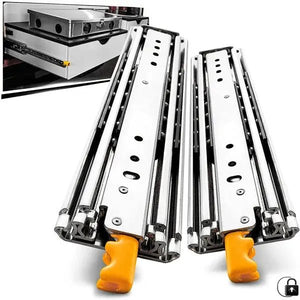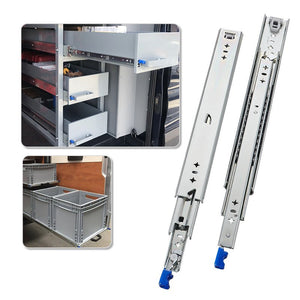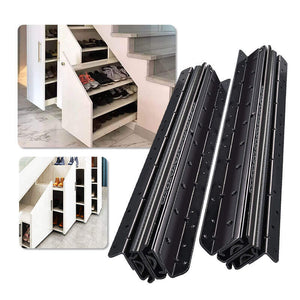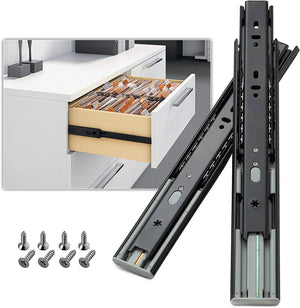I. Introduction
In the realm of furniture and cabinetry, the unsung heroes ensuring seamless functionality are none other than drawer sliders. This comprehensive guide aims to shed light on the pivotal role played by these often-overlooked components in enhancing the everyday experience of using drawers.
Drawer sliders, also referred to as drawer glides, tracks, or runners, are the invisible architects behind the smooth opening and closing of drawers. As we embark on this exploration, we'll demystify the terminology, understand the various types available, troubleshoot common issues, and delve into the innovations transforming the landscape of drawer slider technology.
From traditional side-mount sliders to innovative soft-close mechanisms, we'll navigate the diverse world of drawer sliders, offering insights into their functionality, applications, and how they contribute to both form and function in interior design.
II.What is the Slider in a Drawer Called?
Drawer slides, commonly referred to as drawer glides or runners, serve as the essential mechanical components that facilitate the seamless operation of drawers. Often, customers find themselves pondering, "What is the slider in a drawer called?" Let's break down the key terms to bring clarity to this seemingly intricate puzzle.

1. Drawer Glides:
- Drawer glides, also known as "drawer gliders," are the silent operators responsible for the smooth, controlled movement of drawers. These components typically consist of ball bearings or rollers, allowing drawers to slide in and out effortlessly. Imagine a kitchen drawer that glides open effortlessly to reveal your utensils and closes quietly when the task is done. In this case, the drawer glides are the behind-the-scenes heroes making this seamless operation possible.

2. Drawer Tracks:
- Drawer tracks are the designated pathways or channels that guide the movement of drawers along a predefined route. Consider them as the invisible hands that ensure your drawer follows the correct trajectory. For example, in a filing cabinet, the drawer tracks ensure that each drawer moves smoothly and stays aligned, preventing any misalignment or jamming.
3. Drawer Runners:
- Drawer runners provide crucial support for the weight of the drawer, contributing to stability and balance during its operation. These runners are often made of materials like steel or nylon, and they come in various designs, including ball-bearing or roller runners. Imagine a heavy-duty tool drawer in a garage; the drawer runners allow it to handle the load effortlessly, ensuring durability and reliability over time.
As we move forward, we'll explore not only the terminology but also the functionality that these terms encapsulate, providing a comprehensive understanding for both novices and seasoned furniture enthusiasts.
III. Types of Drawer Sliders
When it comes to drawer sliders, variety reigns supreme. Each type has its unique characteristics, applications, and advantages. Let's delve into the diverse world of drawer sliders to help you navigate the options and find the perfect match for your needs.

1. Side-Mount Sliders:
-
Functionality and Application: Side-mount sliders, as the name suggests, are installed on the sides of the drawer and the cabinet. They are a common choice for various furniture pieces, offering stability and ease of installation. Picture a bedside table drawer smoothly opening from the side.
-
Ideal Use Cases: Ideal for situations where space is a consideration, side-mount sliders are often used in compact furniture like nightstands, dressers, and kitchen cabinets.
-
Advantages: Easy to install, versatile, and suitable for a wide range of furniture styles.
2. Center-Mount Sliders:
-
Functionality and Application: Center-mount sliders are installed at the center bottom of the drawer, providing a unique support structure. This type is less visible and adds a clean aesthetic to furniture. Imagine a desk drawer that seamlessly glides from its center.
-
Ideal Use Cases: Perfect for lightweight drawers in desks, center-mount sliders offer a clean look and are often used in furniture pieces with a minimalist design.
-
Advantages: Concealed appearance, suitable for lightweight applications, and enhances the overall visual appeal.

-
Functionality and Application: Undermount sliders are hidden beneath the drawer, offering a sleek and modern appearance. They provide full access to the drawer, making them a popular choice for kitchen cabinets. Visualize a kitchen drawer effortlessly gliding out from under the countertop.
-
Ideal Use Cases: Commonly used in kitchen and bathroom cabinets, undermount sliders provide a clean and sophisticated look.
-
Advantages: Concealed design, full extension for easy access, and a modern aesthetic.
As you explore these types of drawer sliders, consider the specific needs of your furniture piece and the visual aesthetic you want to achieve. Whether it's the simplicity of side-mount sliders, the clean lines of center-mount sliders, or the modern appeal of undermount sliders, each type brings its own charm to the world of furniture design.
IV. Innovations in Drawer Sliders
In the ever-evolving world of furniture design, innovations in drawer sliders have taken center stage. These advancements go beyond mere functionality, introducing elements that redefine the user experience and contribute to the overall aesthetic appeal of furniture. Let's explore the cutting-edge innovations that are shaping the future of drawer sliders.

-
Revolutionizing Closure: One of the standout innovations is the introduction of soft-close mechanisms. No more slammed drawers or caught fingers – this technology ensures a gentle and controlled closure, adding a touch of luxury to everyday moments. Imagine a kitchen where drawers close with a whisper, creating a serene atmosphere.
-
Application: Widely adopted in kitchen cabinets and office furniture, the soft-close feature enhances safety and reduces wear and tear.

-
Seamless Access: Push-to-open technology eliminates the need for handles or knobs. A gentle push, and the drawer glides open effortlessly. This innovation not only streamlines the visual aesthetic but also adds a layer of convenience. Consider a modern wardrobe where a simple push grants access to your clothes without any visible hardware.
-
Ideal Use Cases: Popular in contemporary furniture designs, especially in minimalist and handle-less styles.
3. Progressive Movement Sliders:
-
Smooth and Gradual: Progressive movement sliders provide a controlled and gradual opening and closing experience. This innovation ensures that drawers open smoothly and close gently without sudden jolts. Picture a bedside table drawer that glides open with a seamless, fluid motion.
-
Advantages: Ideal for delicate items or situations where a softer touch is desired, such as in jewelry drawers or specialty cabinets.
These innovations represent a paradigm shift in how we interact with furniture on a daily basis. Soft-closing drawers, push-to-open mechanisms, and progressive movement sliders are not just features – they are enhancements that elevate the functionality and style of furniture.

V.Conclusion
Drawer sliders are essential components that play a vital role in the smooth operation of drawers. By understanding the different types of drawer sliders, their key features, and common issues, you can make informed decisions when choosing the right sliders for your needs.
- Drawer sliders are an important consideration when choosing furniture. When shopping for new furniture, take the time to inspect the drawer sliders to ensure that they are of high quality and will provide smooth operation for years to come.
- Drawer sliders can be upgraded or replaced to improve the functionality and aesthetic appeal of existing furniture. If you are unhappy with the performance of your current drawer sliders, you can consider upgrading to a different type or model.
- Drawer sliders are a relatively inexpensive investment that can make a big difference in the everyday use of your furniture. By choosing the right drawer sliders and taking care of them properly, you can enjoy smooth, trouble-free operation for years to come.
By following the tips and insights provided in this guide, you can ensure that your drawer sliders function properly for years to come.
FAQ
Q: What are drawer slides?
A: Drawer slides are hardware accessories installed on drawers and cabinets to support and slide drawers.
Q: What types of drawer slides are there?
A: There are three main types of drawer slides: side-mounted slide rails, center-mounted slide rails and bottom-mounted slide rails.
Q: What are the innovative technologies for drawer slides?
A: The innovative technologies of drawer slides mainly include soft closing, push-pull opening and progressive movement.
Q: How to choose drawer slides?
A: When choosing drawer slides, consider the following factors: drawer size and weight, cabinet type and style, and personal preference.
Q: How much does a drawer slide cost?
A: The price of drawer slides varies according to factors such as type, material and function. Generally speaking, side-mounted slide rails are the cheapest and bottom-mounted slide rails are the most expensive.
Q: How to maintain drawer slides?
A: Drawer slides need to be cleaned and lubricated regularly to keep them running smoothly.





